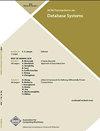迈向空间对象的无痛索引
IF 2.2
2区 计算机科学
Q3 COMPUTER SCIENCE, INFORMATION SYSTEMS
引用次数: 22
摘要
由r树表示的传统空间索引采用复杂的多维树结构,需要在成熟的数据库管理系统(DBMS)中进行大量的工作来实现。支持空间查询的另一种方法是基于映射的索引,它将数据和查询都映射到一维空间,这样就可以对数据进行索引,并且可以通过一维索引结构(如B+)处理查询。基于映射的索引只需要实现几个映射函数,与传统的空间索引结构相比,实现的工作量要少得多。然而,使用基于映射的索引的一个主要问题是它们的效率低于传统的树结构。在本文中,我们提出了一种基于映射的空间索引方案,称为大小分离索引(SSI)。SSI配备了一系列技术,包括大小分离、数据分布转换和更有效的映射算法。这些技术克服了现有的基于映射的索引的缺点,并显著提高了查询处理的效率。我们通过大量的实验表明,对于非零区空间对象的窗口查询,SSI的性能比现有的基于映射的索引好两个数量级,并且与r树作为独立实现的性能相当。我们还在两个现成的dbms (PostgreSQL和一个商业平台)上实现了SSI,它们都有r树实现。在这种情况下,SSI比他们提供的空间索引快两个数量级。因此,我们在DBMS实现中实现了比r树更有效的空间索引,同时也易于实现。这个结果可能会颠覆这个领域长期存在的一种普遍看法,即r树是索引空间对象的最佳选择。本文章由计算机程序翻译,如有差异,请以英文原文为准。
Towards a Painless Index for Spatial Objects
Conventional spatial indexes, represented by the R-tree, employ multidimensional tree structures that are complicated and require enormous efforts to implement in a full-fledged database management system (DBMS). An alternative approach for supporting spatial queries is mapping-based indexing, which maps both data and queries into a one-dimensional space such that data can be indexed and queries can be processed through a one-dimensional indexing structure such as the B+. Mapping-based indexing requires implementing only a few mapping functions, incurring much less effort in implementation compared to conventional spatial index structures. Yet, a major concern about using mapping-based indexes is their lower efficiency than conventional tree structures.
In this article, we propose a mapping-based spatial indexing scheme called Size Separation Indexing (SSI). SSI is equipped with a suite of techniques including size separation, data distribution transformation, and more efficient mapping algorithms. These techniques overcome the drawbacks of existing mapping-based indexes and significantly improve the efficiency of query processing. We show through extensive experiments that, for window queries on spatial objects with nonzero extents, SSI has two orders of magnitude better performance than existing mapping-based indexes and competitive performance to the R-tree as a standalone implementation. We have also implemented SSI on top of two off-the-shelf DBMSs, PostgreSQL and a commercial platform, both having R-tree implementation. In this case, SSI is up to two orders of magnitude faster than their provided spatial indexes. Therefore, we achieve a spatial index more efficient than the R-tree in a DBMS implementation that is at the same time easy to implement. This result may upset a common perception that has existed for a long time in this area that the R-tree is the best choice for indexing spatial objects.
求助全文
通过发布文献求助,成功后即可免费获取论文全文。
去求助
来源期刊

ACM Transactions on Database Systems
工程技术-计算机:软件工程
CiteScore
5.60
自引率
0.00%
发文量
15
审稿时长
>12 weeks
期刊介绍:
Heavily used in both academic and corporate R&D settings, ACM Transactions on Database Systems (TODS) is a key publication for computer scientists working in data abstraction, data modeling, and designing data management systems. Topics include storage and retrieval, transaction management, distributed and federated databases, semantics of data, intelligent databases, and operations and algorithms relating to these areas. In this rapidly changing field, TODS provides insights into the thoughts of the best minds in database R&D.
 求助内容:
求助内容: 应助结果提醒方式:
应助结果提醒方式:


